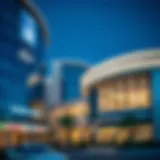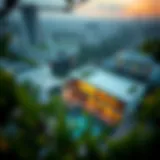Nakhla Dubai: Exploring the City’s Iconic Palm Symbol
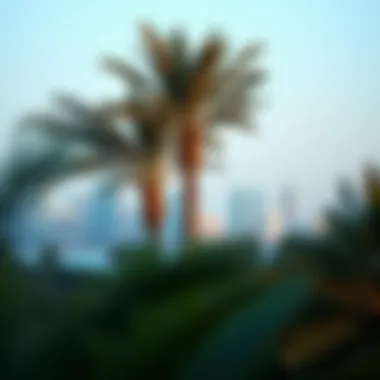

Intro
Nestled within the urban sprawl of Dubai stands a rich symbol that embodies both tradition and modernity: the Nakhla palm. This iconic tree isn’t merely a botanical marvel; it serves as a cultural touchstone, linking the bustling metropolis to its historical roots. Its significance stretches beyond its picturesque image, deeply woven into the fabric of Dubai’s identity and urban development. As we unravel the layers of the Nakhla palm, we’ll explore how it reflects the evolving landscape of this vibrant city.
In a rapid-paced economic environment, understanding Nakhla Dubai offers crucial insights for investors, homebuyers, and developers alike. It represents more than just greenery; it signifies resilience, adaptability, and the melding of tradition with innovation. With urbanization continuously reshaping Dubai, the Nakhla’s presence is an anchor of heritage, revealing the city’s potential for future growth and sustainable living.
This exploration starts with market trends that illustrate the current real estate landscape in Dubai, focusing specifically on how iconic symbols like the Nakhla palm influence investment opportunities and property dynamics.
Cultural Significance of Nakhla in Dubai
The Nakhla palm, often seen dotting the skyline and landscapes of Dubai, is not just a tree but a beacon of the cultural tapestry that weaves through the city’s identity. To understand its significance, one must delve into its historical roots, its presence in local narratives, and its representations in the arts.
Historical Roots and Symbolism
The history of Nakhla in Dubai is rich, stretching back centuries, intertwining with the livelihoods of its people. Historically, the date palm served as a lifeline in the harsh desert environment. It provided not only sustenance through its sweet fruit but also materials for shelter and everyday objects. The tree symbolizes resilience and survival in a place where the environment can be unforgiving.
In folk tales, Nakhla often represents strength and perseverance. These narratives, passed down through generations, highlight its significance in community gatherings, festivals, and rituals that celebrate Arabic heritage. The palm is not merely flora; it holds the very essence of hope and continuity in the ever-changing landscape of Dubai.
Nakhla in Local Traditions and Folklore
In the heart of the Emirati culture lies a reverence for the Nakhla. Local traditions often incorporate the palm into festivals and communal events where families gather to partake in dates, reflecting on the joys of togetherness and gratitude. During the month of Ramadan, for instance, the dates from these palms are highly prized for breaking fast, showcasing the fruit's role not just as food, but as a symbol of hospitality and sharing.
Folklore also tells stories of the Nakhla. It's common to hear tales of how early Bedouins relied on the palm for both sustenance and shelter, weaving it into the fabric of their survival. These stories imbue the palm with attributes of wisdom and nurturing, making it an essential part of local identity.
Representations in Art and Literature
The Nakhla has inspired countless artists and writers. Its silhouette against the sunset is a favorite subject among photographers, while painters often portray its graceful form in their works, symbolizing beauty and strength combined. In literature, the palm features prominently as a metaphor for resilience; many poets have captured its essence, linking it to themes of endurance and cultural pride.
Moreover, public art installations in Dubai sometimes feature the Nakhla as a central theme, blending modern artistry with a traditional symbol of the region. This interplay often resonates with both residents and visitors, making it a functional piece of landscape architecture that pays homage to the rich history behind this iconic palm tree.
"The Nakhla is not just a tree, but a living testament to Dubai's spirit of survival and community."
Ecological Importance of Nakhla
The ecological significance of Nakhla in Dubai goes beyond mere aesthetics. This iconic palm tree is intricately woven into the fabric of Dubai’s ecosystem, fulfilling vital roles within the environment. From providing habitat for various species to maintaining soil health, the Nakhla serves functions that promote biodiversity and resilience in an urbanizing landscape. Understanding these roles is essential for top decision-makers, especially as they steer developments towards a sustainable path.
Biodiversity and Habitat Creation
Nakhla palms are more than just a sight for sore eyes; they are essential participants in Dubai's ecological web. They provide homes for numerous fauna, from insects to birds, creating pockets of biodiversity. For instance, native birds like the Collared Dove and various insects thrive in these palm environments, benefiting from the shade and fruit produced by the tree. This promotes not just animal life but also fosters a thriving community of flora beneath their fronds, which contributes to overall ecosystem health.
Moreover, the roots of Nakhla trees help bind the soil, lessening erosion and promoting a stable habitat for other plants. This is crucial in a desert city where plant life faces constant challenges from harsh weather conditions. Maintaining such habitats aids in preserving Dubai's natural heritage in the face of relentless urban expansion.
Environmental Sustainability and Urban Landscaping
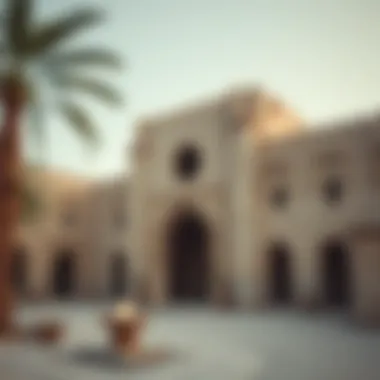

Integrating Nakhla into urban design speaks volumes about sustainable development. Authorities in Dubai are increasingly recognizing that these palms don't just beautify the landscape; they also contribute to environmental sustainability. By increasing green coverage with Nakhla, cities can mitigate heat islands typically prevalent in urban settings. This is particularly evident in public parks and along walkways where Nakhla palms provide shade, reducing the need for artificial cooling in surrounding structures.
Additionally, landscaping choices that emphasize the use of Nakhla help local flora adapt better, promoting success in urban gardening initiatives. This approach not only enhances the visual appeal of Dubai's neighborhoods but also promotes environmental stewardship among residents and visitors alike. Without a doubt, Nakhla plays a multi-faceted role that aligns with eco-friendly planning and preservation efforts.
Climate Adaptation and Resilience
Climate change represents an ongoing challenge for urban environments, and Nakhla trees exhibit remarkable resilience to various climatic conditions. Their ability to thrive under high heat and minimal water conditions exemplifies adaptability, making them an ideal choice for Dubai’s arid climate. Widespread planting of these palms can significantly assist cities in adapting to climate change effects, such as extreme temperatures and unpredictable weather patterns.
Furthermore, Nakhla supports urban cooling, which is pivotal as cities like Dubai grapple with rising temperatures. Research indicates that green spaces help alleviate heat, dramatically reducing the overall temperature of urban areas, thus serving as a natural air conditioning system. This natural mitigation strategy aligns with Dubai's commitment to becoming a leading example of sustainability in urban planning.
"The Nakhla palm is not just a tree; it is a testament to resilience and adaptability in the face of modern challenges."
In summary, the ecological importance of the Nakhla palm cannot be overstated. It acts as a keystone species within the urban landscape of Dubai, enriching biodiversity, enhancing sustainability, and serving as a crucial element in climate adaptation strategies. Emphasizing such ecological facets will help ensure the continued health and vibrancy of Dubai’s environment as the city evolves.
Nakhla and Dubai’s Urban Development
The Nakhla palm is not just a symbol of heritage; it plays a pivotal role in shaping Dubai’s urban identity. The palm tree’s presence is deeply intertwined with local traditions, but it transcends mere aesthetics. Nakhla has become a critical element in integrating green spaces into the concrete jungle of Dubai, which is rapidly evolving. This integration is not just about beautifying the city—it's about creating a sustainable environment that can withstand the pressures of urban growth.
Integration into Urban Design
Incorporating Nakhla into urban design showcases a commitment to balancing natural elements with urbanization. Developers recognize that having palm trees like Nakhla enhances the quality of life for residents and visitors alike. These palms serve as natural air conditioners, reducing heat and improving air quality. Moreover, they offer habitats for various wildlife, promoting biodiversity in urban settings.
When constructing new neighborhoods or business districts, the inclusion of Nakhla is deliberate. Landscape architects and city planners ensure that these trees are strategically placed to create inviting public spaces. For example, parks featuring Nakhla provide a serene refuge, a stark contrast to surrounding high-rises. The juxtaposition encourages social interactions and supports community activities, enriching the urban fabric.
Case Studies of Palm-Centric Developments
Several developments in Dubai have set a precedent for integrating Nakhla into urban planning:
- Palm Jumeirah: An iconic example where the Nakhla palm is not only part of the landscape but also a key selling point for luxury residences. Here, the palms line walkways and beaches, providing both aesthetic and functional benefits.
- Dubai Marina: In this bustling district, Nakhla can be spotted lining the waterfront, creating a vibrant atmosphere that attracts tourists and locals alike. The careful placement enhances the waterfront's appeal while providing shade for leisurely strolls.
- Al Zahra Park: This park integrates natural landscapes while featuring clusters of Nakhla. The design not only beautifies the space but also promotes recreation and relaxation, urging families to gather and enjoy nature within the city.
These case studies reveal a broader trend where urban spaces increasingly prioritize sustainability through the deliberate inclusion of native flora. The aim isn't simply ornamental; it's about establishing a long-lasting relationship between nature and urban life.
"Nakhla represents more than just a tree; it is a vital part of Dubai's commitment to sustainable development and urban living."
Economic Implications of Nakhla Cultivation
The economic implications of Nakhla cultivation in Dubai extend beyond mere aesthetics and greenery. This symbol of the city plays a crucial role in generating revenue, supporting local businesses, and enhancing the overall appeal of Dubai as a bustling urban metropolis. Nakhla does more than thrive in the desert; it contributes significantly to the economy, shaping various sectors from tourism to agriculture.
Role in Tourism and Hospitality
The connection between Nakhla and tourism is as deep-rooted as the palm's hardy roots. Tourists flock to Dubai not only for its luxury but also for its unique blend of tradition and modernity. Nakhla represents this blend perfectly.
- Cultural attractions: Palm trees, including Nakhla, often adorn public parks, upscale hotels, and vibrant shopping districts like The Dubai Mall. These scenic settings enhance the visual appeal, making them prime spots for tourists to snap photos.
- Unique experiences: Tourists participate in cultural activities revolving around Nakhla, such as date tastings or guided tours through palm groves, providing them with a direct connection to local heritage. This aspect fosters a deeper understanding of the Emirati culture.
- Hospitality and events: Many luxury hotels emphasize their proximity to palm landscapes, offering terraces and lounges where guests can unwind among Nakhla trees. Such settings are often utilized for weddings, making the venue even more attractive to potential clients.
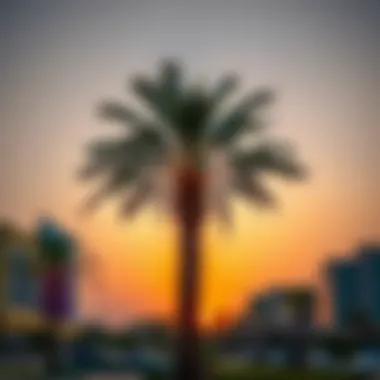

One can sum up the impact of Nakhla on tourism by saying it creates an alluring stage, drawing people from around the world who are eager to experience the local culture with a modern twist.
Agriculture and Local Economies
While Dubai is known for its skyscrapers and bustling markets, agricultural growth rooted in Nakhla cultivation provides an unexpected but essential contribution to the local economy.
- Sustainable agriculture: Nakhla trees are relatively easy to maintain and adapted to the local climatic conditions. Thus, farming these palms requires less water than other crops, supporting sustainable agricultural practices in an arid environment.
- Job creation: The nurturing and harvesting of date palms lead to job opportunities for local residents. This broken-down labor force contributes to the overall economy. Farms that focus on Nakhla cultivation often employ seasonal laborers and full-time staff who engage in various tasks, boosting local employment rates.
- Export potential: The high demand for dates, particularly Medjool dates harvested from Nakhla, places Dubai on the international agricultural map. Sales to markets across the Middle East and even abroad provide additional sources of income for local farmers. Dates from Dubai maintain a stellar reputation for quality, and their export helps to raise the profile of the city as a significant agricultural exporter.
To conclude, Nakhla cultivation strengthens not only the economy but the cultural narrative of Dubai. Its presence is a welcome reminder that the desert’s beauty can go hand-in-hand with economic vibrancy. In understanding this relationship, one can appreciate the challenges and benefits that lie ahead for both the palm and the city it symbolizes.
The Nakhla stands tall, not only as a symbol of resilience but as a cornerstone of Dubai's economic landscape.
For further reading on the economic role of Nakhla, consider exploring resources at Britannica and Wikipedia.
Challenges Facing Nakhla in Dubai
Nakhla, while emblematic of Dubai's heritage, is increasingly confronted with a myriad of challenges. These pressures threaten not only the palm's survival but also the cultural and ecological identity of the city. By analyzing these challenges, we can better appreciate the depth of the palm's significance and the urgent need for sustainable measures.
Urbanization Pressures
Dubai has undergone rapid urbanization over the past few decades, which brings with it significant pressures on the natural landscape. As more skyscrapers and homes pop up, the space for traditional trees like the Nakhla diminishes. Development projects push these palms to the fringes, often altering ecosystems they support. They're not just trees; they're vital symbols and habitats.
Urban sprawl leads to the following concerns:
- Loss of Habitat: The shrinking green spaces mean fewer niches for wildlife dependent on Nakhla.
- Increased Pollution: Urban areas often suffer from higher pollution levels which can impact palm health.
- Water Scarcity: With construction needing water, the competition intensifies, often leaving less for local flora.
With these pressures swelling, one can’t help but ponder: what does it mean for a city to prioritize its palm heritage amidst relentless growth?
Climate Change Impact
As if urbanization isn’t enough, climate change casts an even larger shadow over Dubai's flora, including the Nakhla. Rising temperatures can be detrimental, causing stress on the palm trees. Increased humidity and unpredictable rainfall patterns create challenges for maintaining healthy ecosystems.
Specific impacts from climate change include:
- Drought: Less rainfall affects Nakhla’s growth and fruit production.
- Temperature Extremes: Higher temperatures can lead to heat stress, which may stunt their growth or even lead to tree loss.
- Pest Proliferation: Warmer climates can increase pest populations that distress these palms, leading to potential infestations.
The effect of climate change paints a concerning picture that warrants necessary attention and action from both governmental bodies and the public.
Conservation Efforts and Public Awareness
Realizing the consequences of urban pressures and climate change, several organizations and local government initiatives are beginning to prioritize the conservation of Nakhla. Initiatives range from community plantings to educational programs that inform residents about the importance of these palms.
Strategies currently in place or being discussed include:
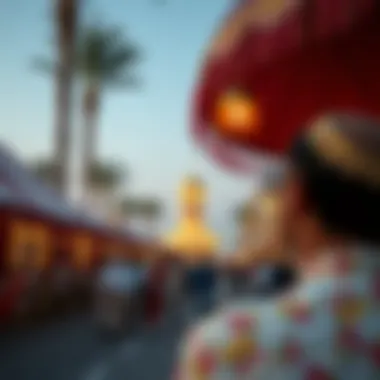

- Public Awareness Campaigns: Engaging the local community about the cultural heritage of Nakhla and its environmental benefits.
- Urban Planning Regulations: Advocating for necessary zoning regulations that protect existing palm populations.
- Sustainable Landscaping: Incorporating Nakhla into Dubai's urban landscapes, providing both aesthetic and ecological value.
"The Nakhla isn’t just a tree; it’s a pivotal piece of Dubai’s rich tapestry. The future hinges on our collective effort to nurture it."
By emphasizing conservation and fostering a collective awareness, Dubai's residents, investors, and urban developers can work hand-in-hand to secure the future of Nakhla in this city of gleaming towers.
It's essential to address these challenges holistically to preserve what makes Dubai unique. The balance between modernity and tradition is delicate, yet achievable.
Future Perspectives on Nakhla and Dubai
As Dubai marches into an era characterized by swift urban evolution, the future of Nakhla—an emblem of the city’s identity—becomes increasingly relevant. Understanding the potential pathways for Nakhla's integration into urban planning is crucial for stakeholders including investors, developers, and residents alike. The palm tree, more than just a plant, represents resilience and adaptability in the face of changing times. Its preservation holds implications not only for the environment but also for cultural heritage and tourism.
- Preservation of Heritage: Nakhla isn’t merely an aesthetic addition to the urban landscape. It embodies the history and culture of the Emirate. Hence, safeguarding this palm tree promotes a sense of local identity—much needed in an ever-globalizing world. Public initiatives that echo these sentiments must become the norm rather than the exception.
- Economic Benefits: The role of Nakhla extends beyond beauty; it has economic meaning. With a rich tradition in trade and tourism, the palm tree enhances the experiences of tourists and serves as a significant motif in Dubai’s branding. This could lead to an increase in tourism-related revenue, essential for sustaining local economies.
"The Nakhla is not just a tree; it is an integral part of our heritage and future. Its presence in Dubai signifies a bridge between our traditions and our aspirations."
Innovative Approaches to Conservation
Rethinking conservation strategies for Nakhla is necessary for ensuring its longevity and relevance in urban contexts. Innovative approaches could offer sustainable solutions:
- Urban Greening Initiatives: Introducing Nakhla into vertical gardens or rooftop landscapes can breathe life into otherwise sterile urban environments. This would not only enhance biodiversity but also improve air quality, making the city more livable.
- Smart Technology Use: Implementing technologies such as sensors for soil moisture and climate control could optimize the growth conditions for Nakhla. Smart irrigation systems can be extremely useful in ensuring that water, a precious resource in Dubai, is used efficiently.
- Community Involvement: Engaging the community through workshops and educational programs can foster a sense of ownership and responsibility towards the Nakhla. Citizens can learn about its ecological benefits and actively participate in planting initiatives.
Enhancing Citizen Engagement in Sustainability
The role of the citizen in sustainability initiatives cannot be overstated. Encouraging citizen engagement in the context of Nakhla has the potential to transform both community attitudes and environmental outcomes:
- Local Workshops and Green Events: Organizing events centered around Nakhla—such as planting days or cultural festivals—could instill pride in local heritage and increase awareness regarding environmental issues. These gatherings help to create a shared commitment to sustainable practices.
- Social Media Campaigns: Leveraging platforms like Facebook or Instagram to promote Nakhla’s significance can tap into younger demographics. Campaigns that challenge residents to share their „Nakhla moments“ can inspire action and foster community spirit.
- Feedback Mechanisms: Local authorities could develop platforms for residents to provide input on conservation and sustainability efforts. This gives a voice to the public and ensures initiatives resonate with community values, aiding in their success.
By weaving together these innovative conservation strategies and enhancing citizen engagement, the vision for a future where Nakhla thrives in Dubai becomes not just palatable but an inviting prospect for all stakeholders involved.
The End: Nakhla as a Symbol of Resilience
As we draw our discussion to a close, it’s imperative to reflect on how Nakhla truly embodies the spirit of resilience in Dubai. This remarkable palm tree not only symbolizes the city's cultural and historical heritage but also serves as a beacon of adaptability amid the ever-changing urban landscape. The resilience of Nakhla mirrors the enduring identity of Dubai itself, a city that has transformed through relentless ambition and innovative thinking while still honoring its roots.
Summary of Key Findings
A thorough exploration of Nakhla reveals several key insights:
- Cultural Roots: Nakhla is deeply embedded in Dubai's history and plays a significant role in local customs and traditions, illustrating the strong connection residents have with their natural environment.
- Ecological Contributions: Beyond its aesthetic value, Nakhla contributes immensely to the biodiversity of the region. Its ability to thrive in arid conditions supports various wildlife and ecosystems, showcasing the adaptability of life in challenging environments.
- Urban Development: The integration of Nakhla into Dubai's urban planning highlights a commitment to preserving nature in tandem with development. This palm tree isn’t just a pretty face; it’s an integral part of sustainable city planning and urban landscaping.
- Economic Impact: Cultivating Nakhla has significant economic implications, particularly in tourism and agriculture, both vital to the city's economy.
- Future Challenges: This iconic palm faces numerous challenges, particularly from urbanization pressures and climate change, necessitating urgent conservation efforts.
These findings underline not just the significance of Nakhla but also its role as a transformative force in the city’s identity, highlighting that natural elements can co-exist with urban advancement.
Implications for Future Urban Planning
Looking ahead, it’s clear that Nakhla must play a central role in future urban planning discussions. Here’s why:
- Sustainable Practices: Embracing the resilience of Nakhla encourages urban developers to adopt sustainable practices that prioritize the environment without stifling growth. As Dubai continues to expand, incorporating green spaces and native flora is vital for maintaining ecological balance.
- Civic Engagement: Involving citizens in dialogue around the preservation and promotion of Nakhla can foster a sense of responsibility and community pride. Residents rallying for green initiatives could lead to broader support for environmental policies.
- Economic Opportunities: As Nakhla flourishes, so too can tourism centered around cultural and ecological heritage. Proposals to create educational tours focusing on palm cultivation and its historical significance can enhance the visitor experience while contributing to local economies.
- Adaptive Structures: Any new developments should consider how they can coexist harmoniously with Nakhla. Innovative designs that incorporate natural elements can enhance the aesthetic appeal and promote environmental stewardship.
In summary, the future of Nakhla, much like Dubai, hinges on innovative strategies that align heritage conservation with modern development needs. The palm stands as a testament to what can be achieved when resilience is nurtured rather than neglected. Through proactive planning and community involvement, Nakhla will no doubt continue to thrive, embodying the spirit of this remarkable city.
